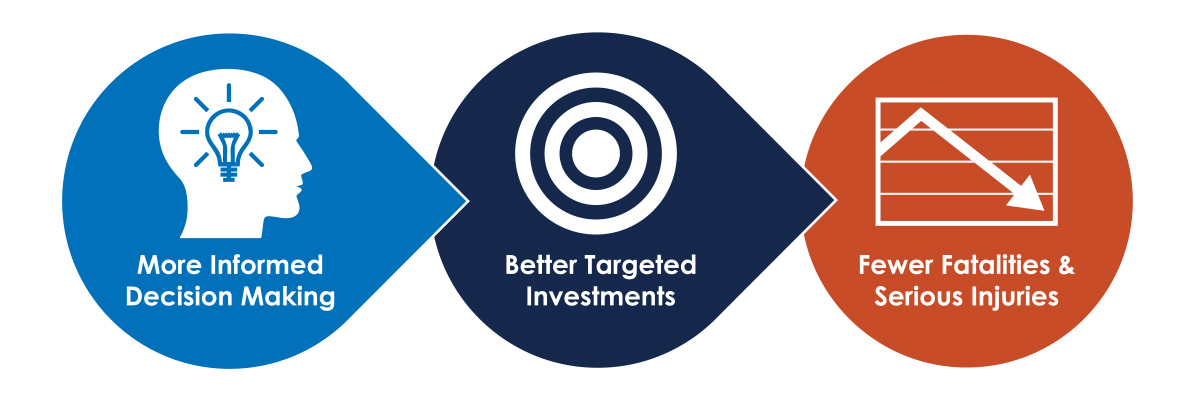For more than a decade, the Federal Highway Administration’s Every Day Counts (EDC) program has promoted proven but underused innovations that enhance roadway safety, improve project delivery, and reduce traffic congestion. Across the country, highway agencies attest to the value of adopting these new technologies and processes, along with a cultural change in how they deploy innovation. In 2021, as the transportation community participates in EDC round six, Innovator is featuring articles that reflect on what the program has accomplished.
Safety is the top priority of the U.S. Department of Transportation and highway agencies throughout the country. From the EDC program’s early years, FHWA has promoted a portfolio of tools and resources to reduce fatalities and serious injuries across the transportation system.
As a result of EDC, the use of informed decision making through data-driven safety analysis (DDSA) is now widespread. EDC also expanded deployment of safety countermeasures such as the SafetyEdgeSM, high-friction surface treatments (HFST), road diets, and innovative intersections.
The EDC focus on DDSA encouraged transportation agencies to adopt the use of advanced data analysis approaches to more accurately predict the safety impacts of projects. While traditional analysis relies on subjective or limited quantitative measures of safety performance, DDSA applies modern software tools and methods to analyze crash, roadway, and traffic volume data. These tools quantify the expected safety impact of each decision in the project development process so agencies can make more informed choices and optimize investments.
Through EDC, FHWA’s marketing and outreach approaches—including webinars, videos, infographics, how-to guides, and a DDSA toolbox—expanded the reach of DDSA to many audiences. In addition to offering technical assistance and training to aid State agencies in incorporating DDSA into processes and policies, the EDC team helped local agencies gain proficiency with DDSA technology and create local road safety plans.
“EDC provided a platform to effectively communicate about DDSA,” said Jerry Roche, FHWA safety engineer and an EDC DDSA team leader. “Unlike other safety countermeasures that are widely known, intuitive, and can be easily described and illustrated, DDSA was a fairly new approach that was hard to describe, difficult to illustrate, and, at first, counterintuitive.”
EDC supplied a national forum to tell transportation professionals and elected officials the story of DDSA—what it is, why it is important, and how it maximizes transportation investments to save lives and prevent injuries. EDC shared best practices and case studies on how DDSA has been successfully implemented in project development and safety management decision making.
 Every Day Counts expanded the use of data-driven safety analysis to enable agencies to target investments with more confidence and reduce crashes.
Every Day Counts expanded the use of data-driven safety analysis to enable agencies to target investments with more confidence and reduce crashes.In addition to expanding DDSA use, EDC broadened the variety of safety tools in agency toolboxes and how they are used. The tools include intersection and interchange designs that accommodate traffic volumes efficiently while reducing conflict points to allow for safer travel. These alternatives to traditional designs include modern roundabouts, diverging diamond interchanges, and intersections with displaced left-turns or variations on U-turns.
By promoting the benefits of innovative intersections, EDC accelerated adoption of Intersection Control Evaluation (ICE) policies and programs, which use a data-driven approach to screen alternatives and identify an optimal geometric and control solution for an intersection. “In EDC, we focused on specific intersection types, not ICE policies. However, we teed up ICE for post-EDC efforts, knowing this would be the next step,” said Jeffrey Shaw, FHWA intersections program manager.
EDC also raised the profile of HFST, a cost-effective countermeasure to improve pavement friction and help motorists keep better control in dry and wet driving conditions. After getting its start in Europe, HFST is now widely used in States to reduce crashes at locations with high risk for crashes, such as curves, ramps, and intersections.
An EDC-promoted countermeasure that has become part of the way agencies do business is the SafeyEdge, a simple solution for mitigating pavement edge-related crashes. A technique that involves minimal time and cost to implement, the SafetyEdge is now used routinely on paving and resurfacing projects in most States.
EDC also encouraged State and local agencies to install road diets as a safety-focused alternative for mixed-used streets that offers high-value improvements essentially for the cost of restriping pavement lanes. By reconfiguring the roadway cross-section, road diets help safely accommodate all users, increase mobility and access, and reduce crashes.
EDC builds on past successes by incorporating innovations introduced in earlier rounds into later rounds. Broadening the use of safety countermeasures and tools to more agencies, including local, and bringing new stakeholders up to speed on innovations as transportation staffs turn over are critical to reducing fatalities and serious injuries. As part of their focus on reducing rural roadway departures, agencies are combining newer tools—including systemic analysis to identify where the greatest risk for serious crashes is likely to be—with countermeasures such as HFST and the SafetyEdge to expand their use and prevent future crashes. Agencies are applying solutions such as road diets to increase pedestrian safety and reduce fatalities at uncontrolled and signalized crossing locations.
Leveraging best practices from past EDC safety initiatives in later rounds has encouraged a culture of change in the transportation community and provided the momentum for agencies to move forward on proven innovations that save lives.
- Cover
- Innovations for a Nation on the Move
- State Transportation Innovation Councils Deploy Homegrown Innovations
- Arizona and Maryland State Transportation Innovation Councils Demonstrate Success
- Crowdsourcing for Advancing Operations
- Next-Generation Traffic Incident Management
- EDC Legacy: A Network of Solutions to Make Roads Safer
- Learn About Every Day Counts Round Six Innovations
- About Innovator
